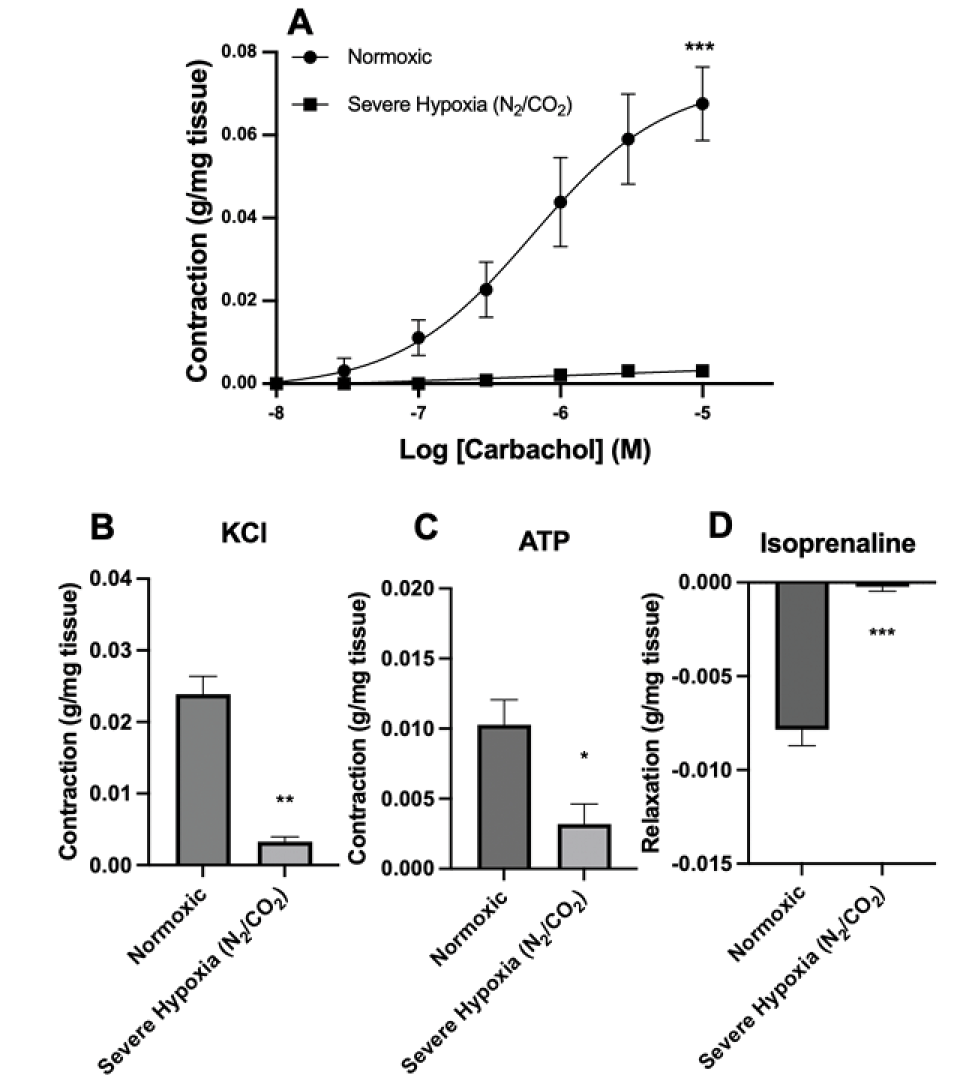Volume 30 Number 2
Effects of acute hypoxia on contractile responses of the bladder mucosa in vitro
Miss Elouise Tye, Dr Donna Sellers, Dr Catherine McDermott
Licensed under CC BY 4.0
DOI 10.33235/anzcj.30.2.39
Objective: 1 in 5 adults will develop some form of bladder dysfunction throughout their lifetime, with increasing numbers in the elderly1. Bladder dysfunction can be characterised by an increase in urinary urgency, frequency, or having to get up from bed to urinate (nocturia).1 Bladder dysfunction has been linked to reduced blood flow to the bladder, leading to reduced oxygen (hypoxia).2 The bladder mucosa, which contains the inner urothelium lining and underlying lamina propria, is an important regulator of bladder function, but the consequences of hypoxia on mucosal function remains uncertain.3 This study aimed to investigate the effects of acute hypoxia on contractile responses of the bladder mucosa in vitro.
Methods: Isolated bladder mucosa tissue strips from female porcine bladders were mounted in 8mL organ baths containing physiological Krebs-bicarbonate solution and gassed with 95% O2/5% CO2 (normoxia) for 15 minutes (maintained at ~1.5 g tension, 37˚ C). Tissues were then switched to either severe hypoxia (95% N2/5% CO2, 18 oxygen %) or mild hypoxia (95% Air/5% CO2, 100 oxygen %), with separate normoxic controls included in each experiment. Cumulative concentration responses (10nM-100µM) to the muscarinic receptor agonist, carbachol, were measured, along with responses to the β-adrenoreceptor agonist, isoprenaline (1 µM), to assess relaxation, and contractions to ATP (10 mM) and high KCl Krebs (60 mM).
Results: Severe hypoxia significantly decreased maximum contractile responses of the mucosa strips to carbachol to 5.0±1.5% of the normoxic (control) response (P<0.001, n=6), with the responses to ATP (P<0.05, n=5) and KCl (P<0.01, n=5) reduced to 32±16% and 14±3.8% of control respectively. However, the potency of carbachol was not affected by severe hypoxia (-LogEC50: control 6.19±0.25 vs severe hypoxia 6.21±0.35). The relaxation responses to isoprenaline were also attenuated (P<0.001, n=6). Mild hypoxia also significantly decreased maximum contractile responses of the mucosa to carbachol (P<0.001, n=6). Responses to ATP and KCl followed a similar trend, although there was no statistical significance. Relaxation responses to isoprenaline were also decreased under mild hypoxia, though not significantly.
Conclusion: The results demonstrate a depressant effect of acute hypoxia on relaxation as well as contractile responses of the bladder mucosa. This change is likely due to a general decrease in mucosal contractility rather than receptor specific changes. These changes may contribute to the bladder dysfunction associated with reduced blood flow and hypoxia.

Author(s)
Miss Elouise Tye1, Dr Donna Sellers1, Dr Catherine McDermott1
1Bond University, Gold Coast, Australia
References
- Maserejian NN, Chen S, Chiu GR, et al. Incidence of lower urinary tract symptoms in a population-based study of men and women. Urology. 2013;82(3):560-564. doi:10.1016/j.urology.2013.05.009.
- Yamaguchi O, Nomiya M, Andersson KE. Functional consequences of chronic bladder ischemia. Neurourol Urodyn. 2014;33(1):54-8. doi: 10.1002/nau.22517.
- Andersson KE, Arner A. Urinary bladder contraction and relaxation: physiology and pathophysiology. Physiol Rev. 2004;84(3):935-86. doi: 10.1152/physrev.00038.2003.


